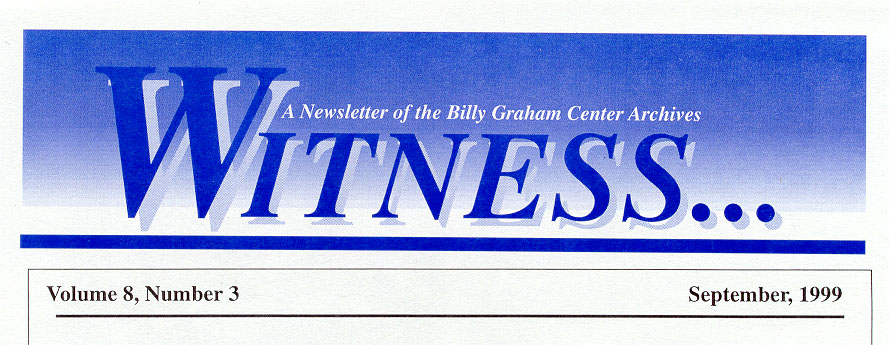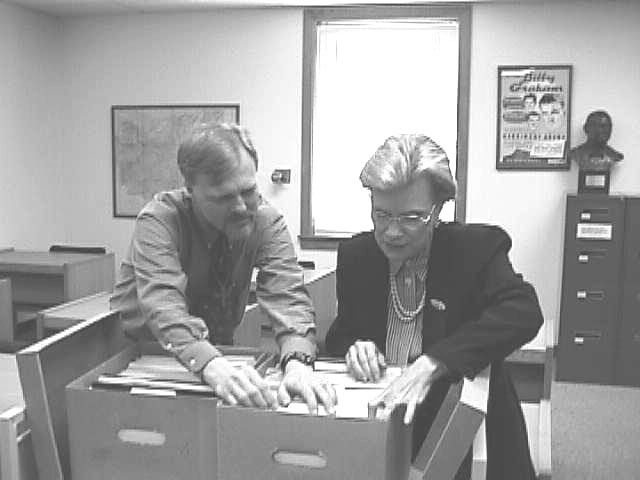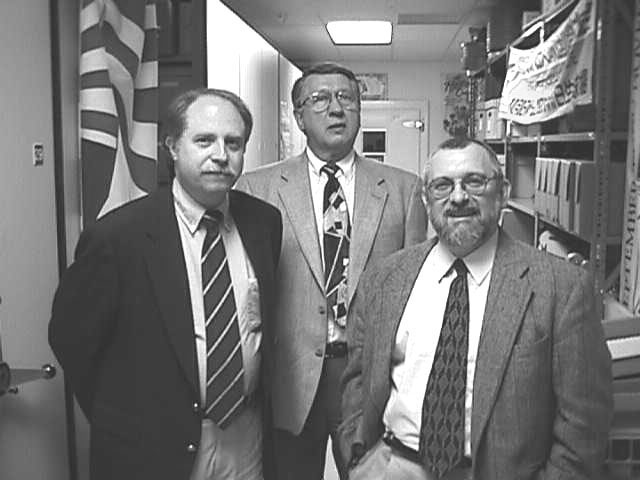Billy Graham Center
Archives
Witness... newsletter, September 1999
Below, very slightly edited because of the different context, are the text and photographs
from the most recent issue of Witness....

*****
1949: Year of Two Milestones for American Evangelicalism

Percy Crawford (left) with Cliff Barrows and Billy Graham. Date and place are unknown, but possibly 1948 at Crawford’s Pinebrook Camp in Pennsylvania
The fall of 1949 was marked by two major events in the history of the American Protestant Evangelical movement. Both events represented forces that would have great influence on the movement in future years.
The first occurred on the East Coast Sunday evening, October 9, 1949. That night those among the minority of Americans who had television sets (and who had them turned to the local ABC affiliate) first heard a blare of trumpets, then saw a placard announcing Youth on the March. As a choir sang, “On to victory, we’ll onward, onward go. On to victory, God will his grace bestow,” the announcer intoned, “Youth on the March, a twentieth century crusade. American history reveals that our country was built by young men with a vision. This vision was based on a sincere reverence for both God and country. Such a man of today is Percy Crawford whom God has raised up to challenge the youth of the twentieth century - to preserve that foundation and build on it for a greater tomorrow.” The choir then rose to a crescendo, singing “Christ is our victory. Praise His holy name!” And so the first American coast-to-coast television broadcast of an evangelistic program began.
Crawford was an evangelist and educator based in the Philadelphia area who had been broadcasting an evangelistic radio program for eighteen years. His young people’s rallies had been one of the models for the Youth for Christ (YFC) movement which had been receiving significant national attention for five years. Now he was venturing into the new field of television. As he announced during the same program, “This is the first Gospel presentation sent coast to coast that we know of.”
Approximately two dozen stations of the ABC network carried this first Youth on the March program. It included several instrumental and vocal music numbers led by Ruth Crawford, Percy’s wife and a talented composer and arranger who was in charge of all the musical aspects of their work. Roy Carver, a weight lifter, hoisted his son one-handed over his head and then gave a brief testimony of his faith in Christ. Finally, after a male quartet sang Rock of Ages, Crawford gave a brief, vigorous, simple message on Matthew 19:16: “Good master, what good thing shall I do that I might have eternal life?”
This was the beginning of the television branch of the electronic church, with all the opportunities, controversies and changes it would bring. A television preacher could now stare into the camera and be seen and heard by more people in an instant than preachers of the previous generation could have spoken to in a lifetime.
A few weeks later, on his November 20, 1949 broadcast, Crawford had disc jockey and country singer Stuart Hamblen on the program and referred to his part in Billy Graham’s Los Angeles meetings. The Los Angeles campaign was the other major event in the fall of 1949. Graham was already well known within Fundamentalist and Evangelical churches, first as a leader of YFC, then as powerful preacher at his own campaigns. But the meetings in Los Angeles, sponsored by the Christ for Greater Los Angeles committee, were the first to get heavy coverage in the secular press and to make Graham known to the nation at large.
The campaign centered around meetings held nightly, beginning September 25th, in a tent at the corner of Washington and Hill Streets. Crowds then considered amazing for a “revival” meeting caused the end of the campaign to be publicly pushed back often. Stories about celebrity conversions in papers of the Hearst newspaper chain and others attracted attention nationally. Graham, song leader Cliff Barrows and soloist George Beverly Shea were entering a new phase of their ministry. The next year would see the incorporation of the Billy Graham Evangelistic Association (BGEA).
The meetings marked the start of a vigorous worldwide push to preach the Gospel and encourage the Christian church by the Association and others influenced by it. The meetings also were part of, and a symbol of the reemergence of Evangelicalism as a distinct and determined voice in American mainstream public discourse.
The Archives has documents about both these events. Collection 357, the papers of Percy and Ruth Crawford, have just opened. It contains dozens of kinescopes of these early live broadcasts which were a model for those that followed. The collection also includes records that tell the story of the Crawfords’ other ministries.
Collection 26 contains audio tapes of fifty-six services from the fifty-seven days of the Los Angeles campaign. Collection 360 includes scrapbooks of newspaper and magazine stories of the period. Collection 74 contains a short film made at the time about the meetings, called The Canvas Cathedral. These materials offer to those who come to the Archives to use them a chance to witness through the eyes and ears of 1949 some of the forces that would shape Christianity in the last half of the century.

Add that appeared in LA paers during the campaign. Click on the image to see the entire ad.
Back to Table of Contents
*****
Early in 1999, Chad Gregory, doctoral candidate from the University of Kentucky, spent weeks in the Archives investigating attitudes toward gender in American Fundamentalism at the turn of the century. “In the late 19th century,” according to Gregory, “women made up a majority of the church members. Where were the men?” He theorizes that men saw the church as overly sentimental. In response, early twentieth century, pastors and evangelists used a vigorous, militant vocabulary and preached a muscular Christianity, partly to attract men back into the pews.
To gather evidence to test his hypothesis, Gregory looked through a number of collections, such as Collection 95, the papers of Fundamentalist leader William B. Riley. But most helpful of all was Collection 61, the microfilm edition of the papers of evangelist Billy Sunday and his wife and manger Helen. (The originals are at Grace College in Indiana.)
Particularly valuable for Gregory were the complete transcripts of dozens upon dozens of Sunday’s sermons. Summaries of the same sermons which he had read elsewhere had often dropped Sunday’s comments on masculinity and the qualities that made a good man, the very information that Gregory wanted most to find.
A few months later, David Settje, associate editor of the Robert A. Taft Papers project, came to do research for his dissertation on American Lutheran reactions to domestic and foreign aspects of the Cold War from 1964 to 1975, especially the Vietnam War. Besides material on Lutherans, he wanted to find Evangelical reactions to the same topics to provide a comparison. He used material from, among other sources, Collection 209, the papers of Eugene Bertermann, producer of the radio program The Lutheran Hour; Collection 8, files of Christianity Today magazine, a prominent voice of Evangelical opinion; Collection 318, the papers of L. Nelson Bell, executive editor of CT; and Collection 192, papers of Harold Lindsell, the second managing editor of the magazine.
Settje commented that, “Although I did not find anything out of the ordinary or materials to change my thesis, the BGEA’s records did buttress my findings and contributed to a greater understanding of nondenominational Christians and how they interacted with Lutherans during this time.” Settje added that, “the financial assistance of the Institute for the Study of American Evangelicals made the entire trip viable. The limited income of a graduate student would have otherwise made the trip nearly impossible.”
Back to Table of Contents
*****



The photos above show some of the Archives’ visitors in the month of May. Top:
Paul Ericksen discusses with Ruth McIntyre some of the records she was consulting
as sources for her study of the cross-cultural communication aspects of the
ministry of Billy Graham, her father. Center: Paula Marolis, archivist for
Campus Crusade for Christ, with records she helped process during the week she
spent at the BGC Archives to study our technique. Bottom: Stan Ingersol, archivist of the Church of the Nazarene, Gordon Wetmore, president of Nazarene Theological Seminary, and Robert Shuster in the Archives storage area. Wetmore and Ingersol had come to study the BGC Archives’ as they planned a historical center for the Nazarene church.
<
Back to Table of Contents
*****
The Archives newest virtual exhibit, available on October 9, focuses on Percy and Ruth Crawford’s pioneering television ministry (see front page article on Crawford). The centerpiece of the display will be footage from the premiere program of Youth on the March which aired on October 9, 1949.
Robert Shuster, director of the Archives, explained why the footage was selected, “Because the Crawfords were important broadcasting pioneers and this program is the first Evangelical television program aired nationwide, the first Youth on the March seemed the right one for the first video file available at our web page. The moments captured in this footage and the personalities behind them deserve recognition.”
Paul Ericksen, who is creating the exhibit, commented “Given that our archives consists of uncounted multitudes of documents (including photographs, audio recordings, video tape, etc.), our holdings are too vast to be digitized and must be used in Wheaton. But we also want to extend the boundaries of our Reading Room. Through the Internet, we deliver to the public some of what they previously had to come to Wheaton to enjoy and learn from, including film footage.”
Look for the exhibit at this address: www2.wheaton.edu/bgc/archives/crawford.htm.
Back to Table of Contents
*****
Last month, Witness... reported on the training that Suk Mei (Irene) Wong was receiving at the Archives to prepare her for her work as head of the Archives of Christianity in China at Hong Kong Baptist University. As part of her training, she processed Collection 471, the papers of (William) Arthur Saunders, which are now available to researchers.
Arthur Saunders (1905-1993) was born in England, emigrated to New Zealand as a farm laborer, and went to China in 1930 as a missionary with China Inland Mission. Collection 471 consists mainly of an oral history interview recorded in 1992. In it, he discusses his training at the New Zealand Bible Institute, his years (1930-1951) in China as a church planter in Gansu province and his later work in Singapore. Here is an excerpt in which Saunders talks about his friend and co-worker in Gansu, the church elder Chao:
“I remember that I gave him the...biography of the great evangelist [John] Sung to read in Chinese. He couldn’t put it down! And I saw him there and he said (and I was within hearing): ‘I am Samson grinding at the mill.’ Because he felt that compared with evangelist John Sung he was just grinding away....
The reason was this. When he was a young man, a missionary and his wife thought ‘Oh this young man has great possibilities. I tell you what we’ll do, we’re going to Cheefoo [northeastern Chinese coastal city that was a center for missionaries and especially for the education of missionary children] to see our children on the coast .... We’ll take Chao with us. He’ll be great help on the road, and there’s a place where there are many educated young women. Perhaps we can find a wife for him.”
Now that is entirely according to Chinese custom. You don’t leave such an important matter for the young people themselves to decide. Their betters do it for them. So, he went to Cheefoo with these folk and he was introduced to a young lady teacher. They were there a couple of months, I guess, and they met from time to time.
And so when they were beginning to think about returning to Gansu, they said to young Mr. Chao ‘So what about it? You’ve met this young lady several times. What about her?’ [He replied] ‘Well I’m sure she’s a very fine young woman.’ ‘Well, would you like us to arrange a marriage for you and take her back to Gansu?’
And he hummed and he hawed and he didn’t know where to look and didn’t know what to say. So they pressed him and pressed him ‘Well, what’s the matter?’ ‘She has natural feet.’ [Unbound feet. Female feet, bound from youth so that those of an adult woman were incredibly tiny, were considered a sign of beauty and gentility.] And to take feet like that back to Gansu, a conservative place, he couldn’t face it. So he went back and he married one with suitably bound feet. I knew her, not a bad woman at all and her children were good children. But I always felt that Elder Chao was a defeated man. He did his duty, he was a solid good character but he felt that he had in a way failed. Very pitiful.”
Saunder’s translation of the elder Chao’s own history of the church and mission work in the city of Tienshui is also part of this collection.
*****
Guides to all the collections mentioned in this newsletter can be found on the World Wide Web at the Archives' home page.
The address (or URL) for a list of collection guides in collection number order is: http://www2.wheaton.edu/bgc/archives/guides/g1.htm
The address for a list of collection guides in alphabetical order, according to the name of the creator of the documents, is: http://www2.wheaton.edu/bgc/archives/guides/g2.htm
Back to Table of Contents
*****
Witness...
Volume 8, Number 3, September 1999
The Archives of the Billy Graham Center is a department of Wheaton College which collects and makes available documents on the part nondenominational Protestant efforts have
played in the spread of the Christian Gospel.
Robert Shuster, Director
Paul A. Ericksen, Associate Director
Janyce Nasgowitz, Reference Archivist
Wayne D. Weber, Archival Coordinator
For further information or to subscribe to the newsletter free of charge, send your name and address to:
Archives of the Billy Graham Center
Wheaton College
Wheaton, IL 60187
or call (630) 752-5910
E-mail:
Home Page: http:/www2.wheaton.edu/bgc/archives/archhp1.html
Back to Table of Contents
Last Revised: 9/25/99
Expiration: indefinite
© Wheaton College 2005





